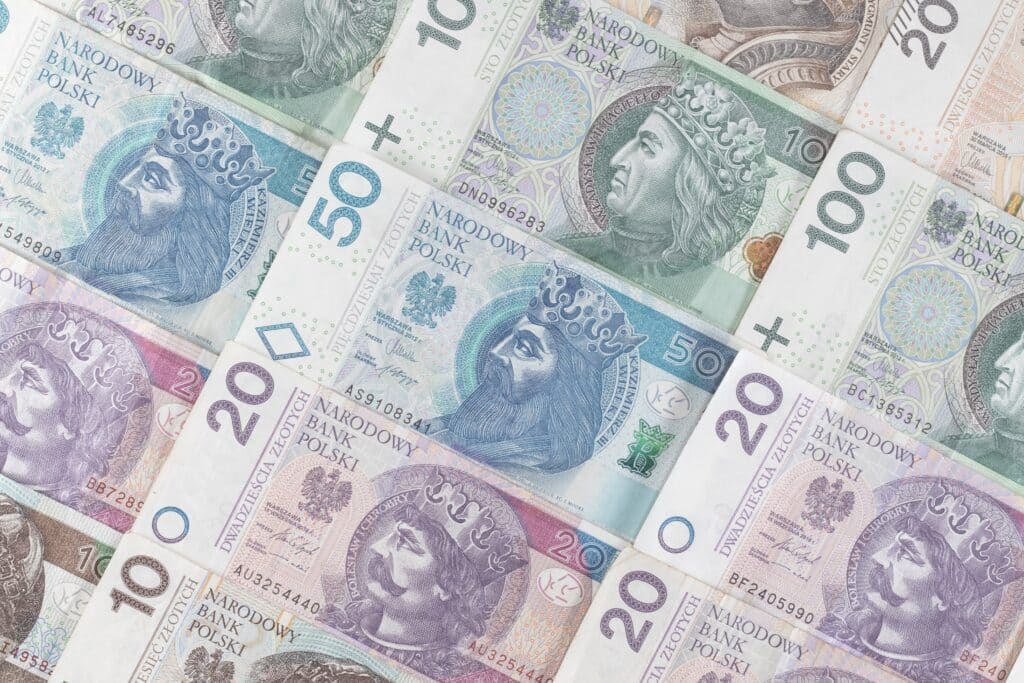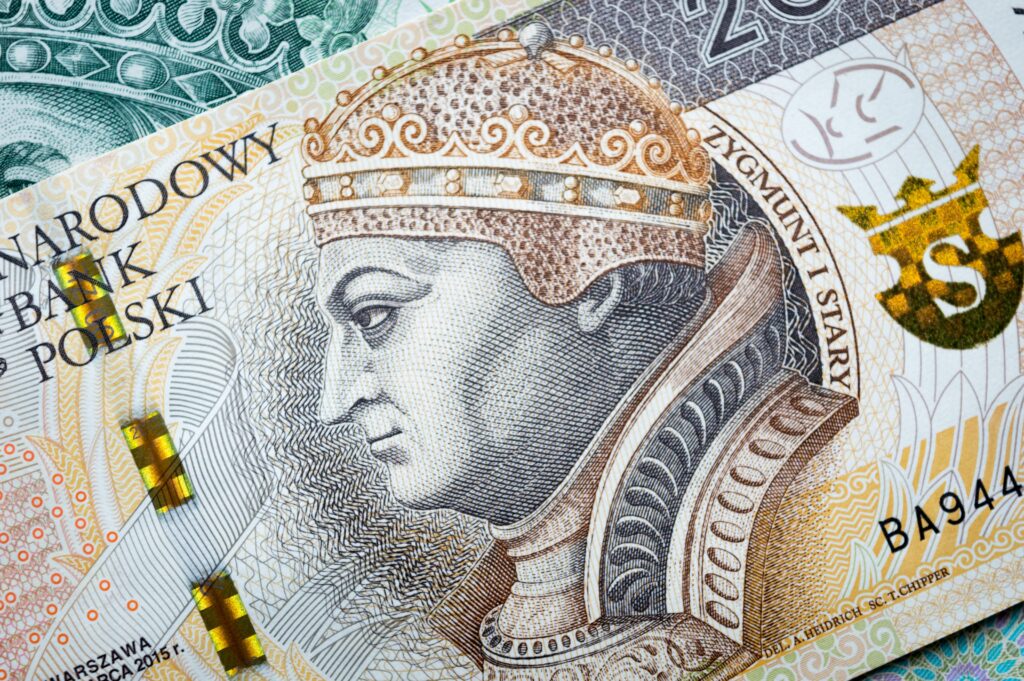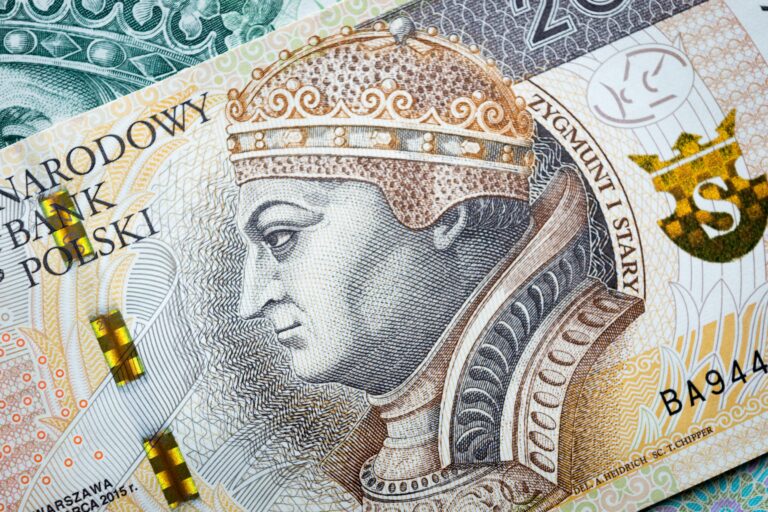
If you are traveling to Poland, becoming familiar with the national currency can help you prepare to make purchases during your stay. Our team here at Remitly created this guide to Polish currency to help. Read on to learn about Poland’s currency and find out how and where to exchange money in the country.
What is Poland’s main currency?
The national currency of Poland is the złoty or zloty. You pronounce the word like “zhu-LAH-tee.” When you make the word plural, it becomes “zlote.”
A zloty can be divided into sub-units called grosz, pronounced like “GROW-shuh.” Its plural form is “groze.” There are 100 groze in one złoty.
Unsurprisingly, złoty is a Polish word meaning “golden,” and it is the masculine version of the adjective. The currency took its name from the gold coins used centuries ago. “Grosz,” however, is not a Polish word; it actually comes from the German word “groschen,” which means “pennies.”
Why is zloty called PLN?
PLN is the official currency code for Polish złoty. Each national currency has its own code used to identify it on currency trading markets. Some people refer to the złoty as PLN due to its code.
What is the zloty currency symbol?
The traditional currency symbol for Polish złoty is zł. The country switched to using PLN as the symbol in 2014, but many Poles continue to use zł.
If you’re typing on a mobile device or a computer that doesn’t have the ł, you can substitute an L without the oblique accent mark, and people will still generally understand what you’re talking about.
How do you write money amounts in Poland currency?
When writing amounts of money in Polish złoty, the currency symbol goes after the number with no space in between. For example, you would write 20 zł for 20 złoty or 50 zł for 50 złoty.
The same is true when writing amounts in grosz only. As an example, you would put 2 gr for 2 grosz or 10 gr for 10 grosz.
To use PLN as the symbol, add a space, so 40 złoty would be 40 PLN.
Does Poland use the Euro?
Poland joined the European Union (EU) officially on May 1, 2004. However, the country does not use the Euro as the national currency.
As a member state of the EU, Poland is obliged to one day replace the Polish złoty with the Euro. However, the National Bank of Poland has not announced any timetable for the conversion.
Poles generally seem content to use their own currency, and there are concerns that switching to the Euro would cause prices to rise. As a result, it is unlikely that a changeover will happen in a short time.
Current Polish zloty coins and banknotes

All the figures on the Polish banknotes are Polish royalty who have an important historical place. Let’s take a look at the denominations for paper bills and who appears on each.
- 10zł: Mieszko I (c. 930–992), a duke who is considered the first historical ruler of Poland.
- 20zł: Boleslaus I the Brave (c. 966–1025), the son of Mieszko I and the first king of Poland. King Boleslaus set Poland up to be a major European power.
- 50zł: Casimir the Great (1310–1370), a king of Poland who is best known for being a peaceful and skillful ruler.
- 100zł: Władysław II Jagiełło (c. 1351–1434), initially the Grand Duke of Lithuania, later became king of Poland, ruling both countries.
- 200zł: Sigismund I the Old (1467–1548), another king of Poland who was known for his religious tolerance.
- 500zł: John III Sobieski (1629–1696), a king of Poland and a soldier who restored the Poland-Lithuania kingdom and protected Poland from the Ottoman Turks.
Coins come in the following denominations:
- 1 gr
- 2 gr
- 5 gr
- 10 gr
- 20 gr
- 50 gr
- 1 zł
- 2 zł
- 5 zł
All grosz and zloty coins have the phrase “Rzeczpospolita Polska,” meaning “The Republic of Poland” in Polish. They also all have the crowned white eagle, considered the Polish Republic’s emblem, on Poland’s coat of arms. The eagle has been a symbol of Poland for centuries and is said to have been a good omen by the founder of Poland, according to legend.
New banknotes produced in Poland have a special feature to help the blind and partially sighted tell bills apart. Each denomination has a distinctive embossed shape featured on it. A person with vision impairment can feel the unique mark to identify the banknotes when paying in or accepting cash.
History of the Polish zloty (PLN)
The zloty has roots in the Middle Ages: 1528 to be exact; however, there have been many changes since then. The use of the name “zloty” did not come back until 1924. Poland continued to use this currency throughout World War II and while being occupied by the Soviet Union. In 1950, a new series of zlote was produced under the currency code “PLZ.” This version of the zloty is no longer considered legal tender. Finally, the zloty we know today was introduced in 1995 with the currency code “PLN,” which is still used.
Poland has produced about a dozen commemorative banknotes to celebrate specific people and events that embrace Polish history and culture. The first time Poland printed these kinds of banknotes was in 2006 for Pope John Paul II. Even though they are considered collector’s items, they are legal tender and can be used like any other banknote.
Here are a few of the moments Poland has celebrated on various zlote:
- The first collector banknote – Pope John Paul II
- The “independence” banknote
- 200th anniversary of the birth of Frédéric Chopin
- 100th anniversary of the awarding of the Nobel Prize to Marie Skłodowska-Curie
- 100th anniversary of the Battle of Warsaw
What is the most expensive Polish coin?
In 2018, a Polish coin from 1621 was sold for $2,160,000 in a New York City auction. It was a commemorative coin that was made to celebrate the Battle of Chocim. In this grand battle, Poland had a victory over the Turks. The coin’s high value is due to its being “struck from gold,” historically important, rare, well designed, and at nearly 70 millimeters in diameter and weighing almost 350 grams … physically impressive,” according to a Coin World article about the auction.
What Is the Polish currency to USD exchange rate?

Currency exchange rates vary based on a variety of factors, including interest rates and inflation. During times of economic turmoil, prices can change in a very short time. As a result, it’s important to get the most recent information possible when looking up exchange rates.
To see the current zloty–to–U.S. dollar exchange rate, check out today’s rate with Remitly. Below are recent rates:
- 1 zloty = 0.24 U.S. dollar
- 1 zloty = 0.21 Euro
- 1 zloty = 0.18 British pound
How much is 1 U.S. dollar in ZLOTY?
As of April 26, 2022, 1 U.S. dollar was worth around 4.14 PLN.
How much is $100 US in Poland?
As of April 26, 2022, $100 USD was worth around 414 PLN.
Can you pay in other currencies in Poland?
If you want to pay in cash, you’ll typically need to have Polish złoty notes and coins. Most places don’t accept any foreign currency.
Can you use euros in Poland?
As of April 2023, you typically can’t use euros in Poland. Poland will likely need to convert to the Euro at some point but has yet to do so.

Places where you can get Polish money in Krakow
If you’re in Krakow, you can obtain Polish currency from a variety of sources, including the following.
Larger hotels
If you’re staying at a hotel that hosts many foreign visitors, you may be able to exchange money from major currencies like the U.S. dollar, the Euro, or the British pound for Polish currency at the front desk or concierge station. Hotels may cap the amount that you can exchange at one time.
Polish banks
Some banks offer currency exchange services, but not all do. Call ahead to ensure that the financial institution you intend to visit will change your foreign currency to złoty.
ATMs
One of the easiest ways to get Polish złoty is to use your ATM card and make a withdrawal at one of the many cash dispensers in Krakow.
ATM cards on most international networks will work in a Polish ATM, provided that your card has a four-digit PIN code assigned to it. If your card doesn’t have a PIN and can only be used with swipe-style electronic card readers, you likely won’t be able to withdraw money.
Kantors
Kantors are the term for businesses that specialize in exchanging currency for Polish złoty. The most reputable ones are on Sławkowska Street near the main square in the city and in the Galeria Krakowska shopping mall attached to the bus and train stations.
How much does it cost to exchange currency?
When you exchange your currency for Polish złoty, you can expect to pay a fee that varies greatly. Poland does not regulate the cash exchange industry, so providers can set rates how they like.
Check with multiple sources beforehand to ensure you get the best rate possible.
Are debit cards and credit cards accepted in Poland?
Many businesses in Poland accept Visa and MasterCard credit cards and debit cards for payment. Some businesses will take American Express as well, but this is less common.
Keep in mind that you will usually be subject to fees from the card issuer when you use your card abroad. Most credit card companies and banks will charge a fee for exchanging the currency from your home country to the Polish złoty. In addition, they may also charge an international fee for using your card in a foreign country.
Be sure to notify your bank or credit card company before you travel to avoid declined transactions due to suspected fraud.

Sending Money to Poland
Send money to Poland with Remitly. New customers may be eligible for a special offer on their first transfer. With Remitly, you can track the transfer and be sure it’s on its way, and our pricing is straightforward, with no hidden fees.
Conclusion
Since other major currencies won’t be accepted in most places, plan to visit a money exchange to get złoty when you arrive. Research your options carefully to ensure you get the best rates when exchanging your currency for Polish money.
